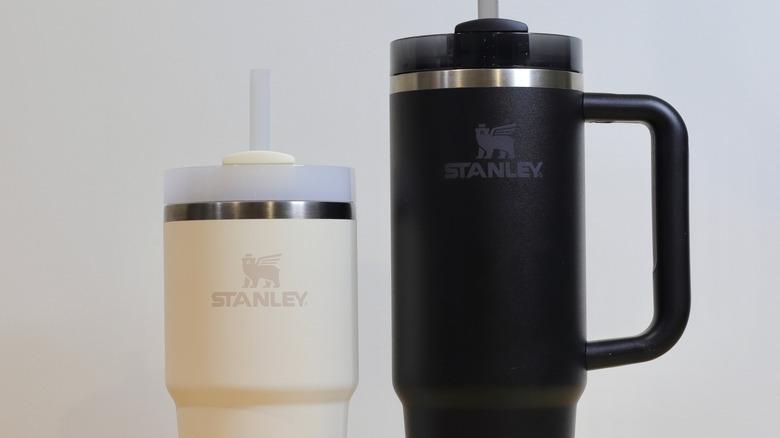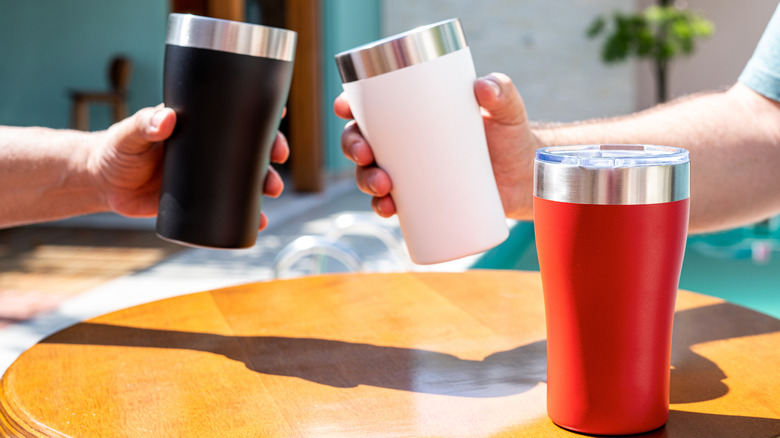Are Stanley Cups Made By Stanley Tools?
Stanley Cups were created by inventor and electrical engineer William Stanley Jr. back in 1913. Their genesis was a result of Stanley's search for a way to keep his coffee hot, as the available vacuum containers of the day were not as durable and reliable. Using his background in engineering, Stanley removed the glass and added charcoal dust as the insulation material between the two stainless steel plates, resulting in a stronger bottle that can be reused every day. Because of the brand name, many assume the cups can be grouped in with other lesser-known Stanley tools and accessories. However, this shared title is just a coincidence.
Stanley cups are owned and made by a company called Pacific Market International, which is a subsidiary of HAVI Group, a logistics and supply chain company. Stanley Tools, on the other hand, is a different organization, whose primary line of business is manufacturing and sales of power tools, apparel, personal protective equipment, and household hardware.
Because of their similar names, in 1966, Stanley Black & Decker approached Aladdin Industries, who at that time was the owner of Stanley cups. This was for a deal that limited Aladdin's use of the Stanley name to insulated containers adapted to keep their contents hot or cold. A new agreement was made in 2012 that amended the use of the Stanley brand name for only insulated or uninsulated beverage or food containers and carrying cases related to those products. Currently, the relationship between Stanley Black & Decker and Stanley seems to have deteriorated, as Stanley Black & Decker recently filed a lawsuit last February 2025 for violations in their previous agreement.
Old classic to trending must have
With the brand's origins dating back to over a hundred years, the durability and practicality of Stanley cups have earned its products good reviews among its many competitors. Stanley cups are made of two layers of stainless steel that are separated by a space between them that acts as a vacuum chamber. The brand even has a lifetime warranty that promises that the cups' performance won't degrade over time.
Designed to be sturdy drink containers for blue-collar workers, Stanley cups today have moved away from their utilitarian niche and now have a much larger market base. Rather than focusing on being a rugged container, Stanley has evolved and now markets itself as a must-have accessory and lifestyle brand. Stanley now features many size and design variations of its bestseller and continues to collaborate with other fashion, sports, and entertainment labels that further increase its product and brand awareness.
In spite of the fact that it has been around for a long time, prior to 2019, the market performance of Stanley was stagnant, and sales of its now best-selling product, the Quencher, were so poor that the company stopped restocking and marketing it. The company's fortunes began to improve in 2019 after the Quencher was featured on a product review website called The Buy Guide, and interest for it grew. Stanley executives then began a series of limited color editions and brand collaborations that sustained its newfound popularity, and as of 2023, over 10 million Quenchers have been sold.
Naming rights and brand protection
Stanley cups went through a resurgence in popularity in recent years thanks to a combination of savvy social media marketing and partnerships. This renewed interest in Stanley cups — despite the fact that they can be a hidden breeding ground for mold — has been a boon for the company, as it went from $75 million a year in sales to a staggering $750 million in 2023. Unfortunately, despite their ongoing market relevance, an incident in 2024 may have caused some reputational damage.
During December of 2024, Stanley had to issue a product recall for 2.6 million stainless steel travel mugs. These defective products were recalled due to a flaw in the lid design that can cause it to come off. Stanley received 91 complaints for this faulty product, which caused 38 people to suffer burn injuries, and 11 of those needed medical attention. Stanley has since asked the owners of the affected products to stop using them and offered free replacement lids.
This recall issue was also part of the reason why Stanley Black & Decker filed its lawsuit against Pacific Market International. Stanley Black & Decker asserts that the product recall may cause potential damage to its own Stanley brand, because the recall made it seem the defective products came from its own company rather than Pacific Market International. As the lawsuit is currently ongoing, it may take time before any resolution on the name usage would be forthcoming. As it stands today, Stanley is a separate entity from Stanley Black & Decker and continues to use the name Stanley for its products.


